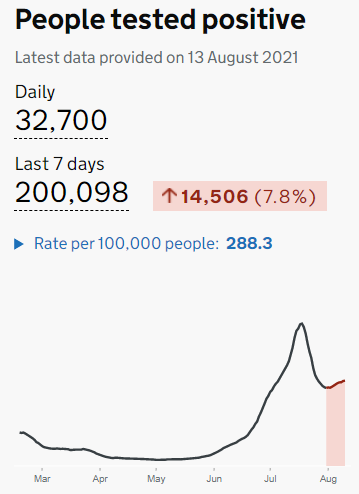
First COVID sitrep of the New Year: The number of omicron variant COVID-19 infections remains extremely high in the UK and still far higher than anything we have seen up until last month. Here’s what’s happening in the NHS… 1/14 

London was the first UK region to get hit by the omicron variant before spreading across the country. This week’s million dollar question is whether new infections have peaked in London. Many say yes, but it seems too early to be sure…. 2/14 

…and being sure we are past the peak is a key moment in the NHS response to each wave. Once we *know* we are past the worst, we can stop planning extra covid capacity, we can re-focus on the patients we have, and all the other routine NHS work. This makes a big difference. 3/14
A quick note for the sceptics: yes it’s true that a lot more people are getting tested, but the *proportion* who test positive is higher than ever (blue line in graph). Like it or not, the pandemic cannot be explained away by picking and choosing data to suit. 4/14 

The best measure of NHS pressure from covid is the number of infected patients in hospital. This is still rising, both in London and across the UK. But we hope that the number of hospital in-patients in London will peak in the middle of January. 5/14 

Compared to previous waves, the number of patients in hospital with ‘incidental’ COVID infection is higher. These are people admitted for other problems, tested as routine for infection control, and found to be positive. Almost 1 in 3 covid in-patients are now incidental. 6/14
A fifth of NHS intensive care beds are currently occupied by patients with covid but this has changed little since November. Lots of patients are developing serious covid (needing hospital admission) but fewer than expected are developing life-threatening covid illness. 7/14 

The major pressure on the NHS is now on general wards, such as respiratory wards, and not ICU. Some hospitals are re-deploying staff to support teams in these areas. Extra help from army medics is most welcome, but we are still very short staffed. 8/14
bbc.co.uk/news/uk-englan…
bbc.co.uk/news/uk-englan…
Our main staffing problem is sickness absence due to covid or self-isolation, as well as other reasons. Currently, almost one in ten of our colleagues are unable to work. This is far higher than normal, while we have lots of extra patients to treat. 9/14
bbc.co.uk/news/uk-599104…
bbc.co.uk/news/uk-599104…
Lots of discussion this week about how much longer covid will last. The simple fact is the virus will be with us for many years to come. We hope it will be less problematic in future but learning to live with covid includes learning that people continue to die from covid. 10/14
People who aren’t vaccinated are at far higher risk of developing life-threatening covid than those who are. The majority of patients in ICU with covid are not vaccinated. Data from @ICNARC show this increased risk affects all adult age-groups. 11/14 

Remember, vaccine hesitancy is most common amongst those most vulnerable to covid - the under-served and income deprived – the ones we know have the worst health outcomes in our society. Being anti-vax is a luxury only the wealthy can afford... 12/14
NHS pressures remain very high. It’s NOT just another winter. We are struggling to deliver all of our ‘routine’ work such as surgery and cancer care. Emergency departments and GP surgeries remain very busy. Stay vaccinated and keep up your amazing efforts. 13/14 

We must not forget that covid is a global disease. @WHO recorded 2.4 million infections in the last DAY. The UK is forever vulnerable while covid surges back and forth between countries. Global vaccination campaigns are vital because no-one is safe until we’re all safe. 14/14 

• • •
Missing some Tweet in this thread? You can try to
force a refresh


















